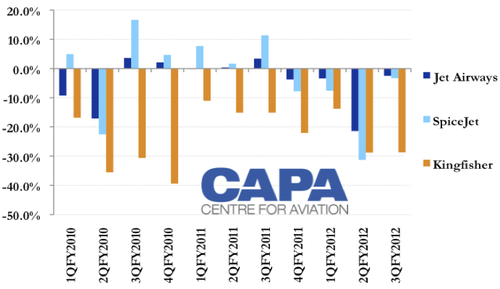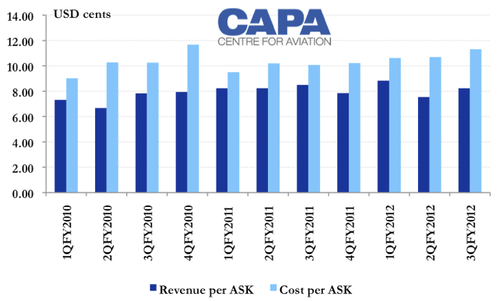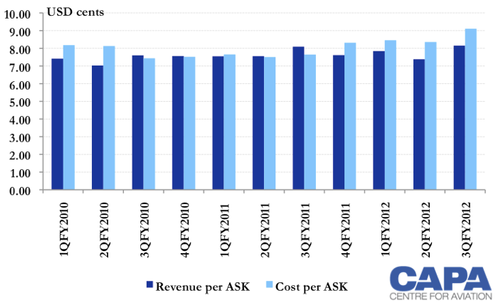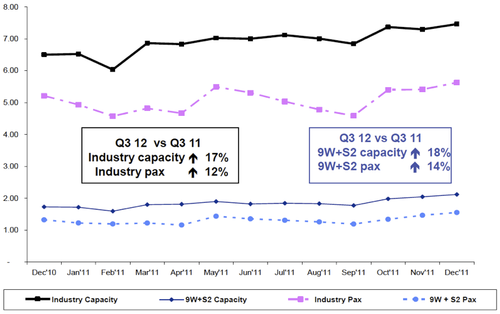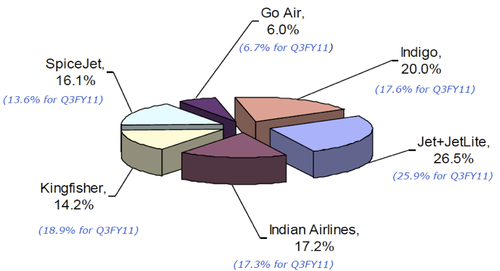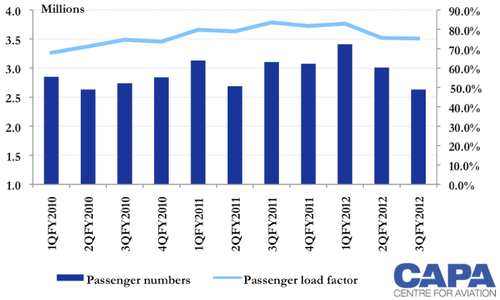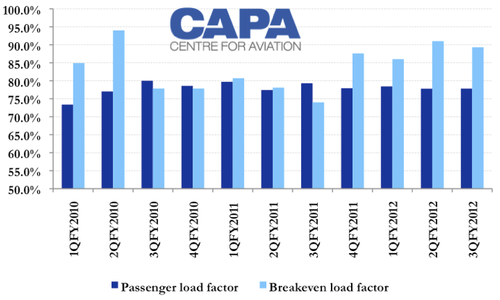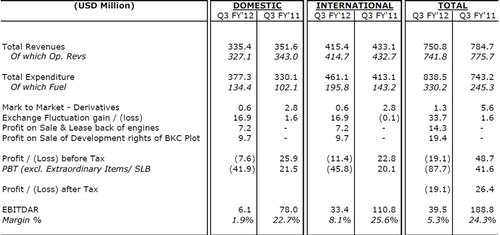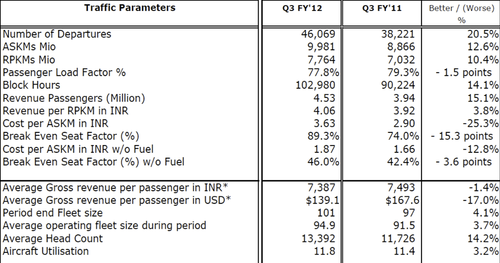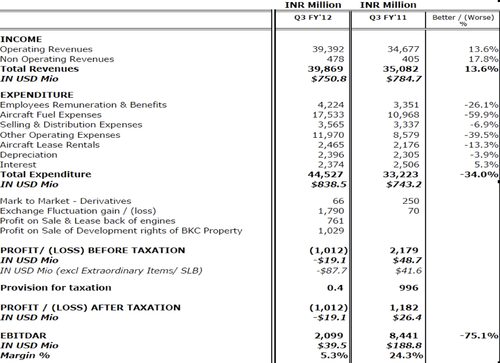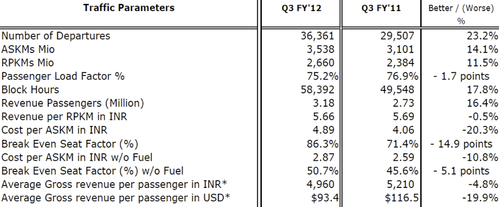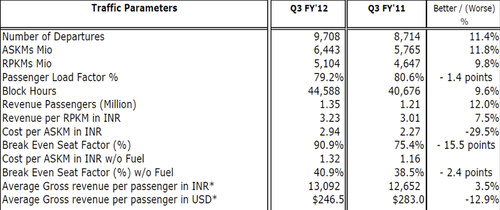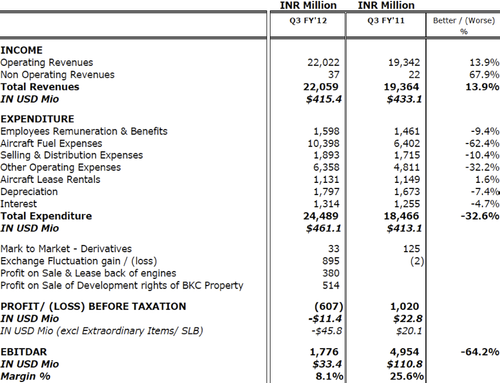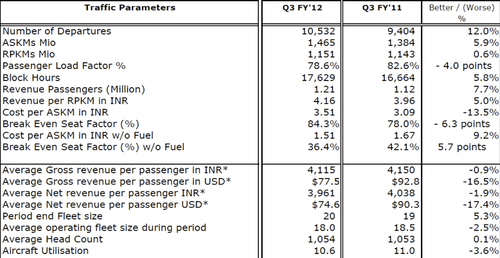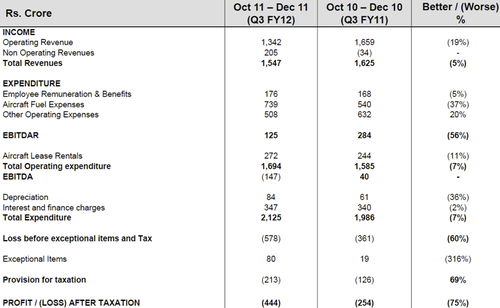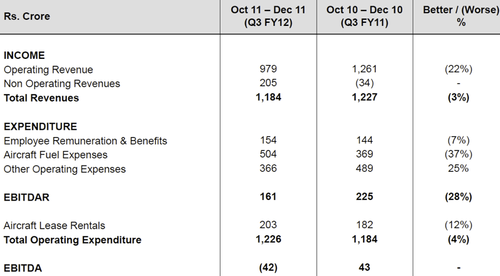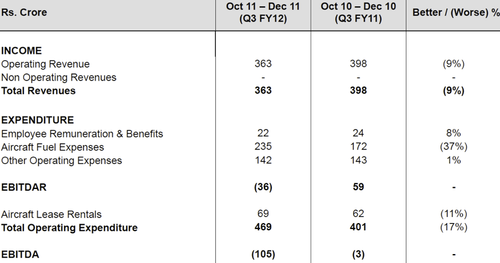Heavy losses for Kingfisher Airlines, Jet Airways and SpiceJet in challenged Indian aviation sector
The challenges continue in India's aviation sector with the country's three-listed carriers - Kingfisher Airlines, Jet Airways and SpiceJet - posting losses in the three months ended 31-Dec-2011 (3QFY2012), traditionally the strongest quarter for Indian carriers, marking four consecutive quarters in the red.
Kingfisher Airlines, as expected, posted the heaviest loss among the listed carriers in what was a tough quarter for India's aviation sector as a whole.
Government-owned Air India is also heavily loss-making. SpiceJet, while also feeling the pain, is better placed than some of its rivals, while unlisted IndiGo is likely to be the sole profitable carrier in the current fiscal year.
Jet Airways, SpiceJet and Kingfisher net profit (loss) margin: 1QFY2010 to 3QFY2012
The losses in the quarter reflect not only issues at the individual carriers but some fundamental and structural challenges in the Indian aviation sector. As previously noted, growth in the robust domestic market has failed to translate into profits for India's airline industry, where all the major carriers except IndiGo are loss-making, as a result of the impact of high jet fuel costs (during the quarter crude oil price remained well above the USD100 mark to constitute around 40-50% of airline operating costs), compounded by heavy taxation, inefficient infrastructure and an inability to raise fares in a highly competitive market. In addition, rising debt levels and a depreciating rupee (leading to increased payments for fuel and aircraft rentals) are placing further pressure on margins. As a result, the nation's airlines are seeing a sharp increase in their cost base at a time when yield and unit revenue growth is pressured.
Carriers in the market are attempting to rectify this situation through a number of measures such as entering into sale and leaseback agreements to reduce debt and interest costs, restructuring their operations and divesting non-core assets.
The road to recovery for the nation's airlines will likely be bumpy, with the heavily indebted sector having already accumulated losses of USD6 billion in the last five years, which will be compounded by a record USD2.5 billion loss in the 12 months to 31-Mar-2012. Lender banks are now increasingly concerned about their exposure to the troubled sector at a time when financing requirements are significant and the net worth of the nation's airlines have declined substantially, as noted by the carriers' auditors.
Auditor commentary for SpiceJet, Kingfisher Airlines and Jet Airways
|
Carrier |
Auditor's report |
|---|---|
|
Kingfisher Airlines' auditors have raised concern over its ability to remain a "going concern", stating it would need to inject more funds to remain in such a position. "The financial statements being prepared on a going concern basis, notwithstanding the fact that the company's net worth is eroded. The appropriateness of the said basis is inter-alia dependent on the company's ability to infuse the requisite funds for meeting its obligations," BK Ramadhayani & Co said in its report. Kingfisher Airlines chairman and MD Vijay Mallya, upon the release of the carrier's unaudited financial results for the nine months ended 31-Dec-2011, conceded that the company has "incurred substantial losses and its net worth has been eroded". He continued: "However, having regard to capital raising plans, group support, the request made by the Company to its bankers for further credit facilities, planned reconfiguration of aircrafts and other factors, these interim financial statements have been prepared on the basis that the Company is a going concern and that no adjustments are required to the carrying value of assets and liabilities." |
|
|
Jet Airways' auditors, Deloitte Haskins & Sells and Chaturvedi & Shah, at the end of 2QFY2012 warned the carrier needs to raise funds in order to meet its obligations, fund the operations of loss-making JetLite and ensure the carrier continues as a 'going concern'. "The appropriateness of the assumption of going concern is dependent upon the company's ability to raise requisite finance or generate cash flows in future to meet its obligations, including financial support to its subsidiary," the auditors said. |
|
|
SpiceJet's auditors, S R Batlibol & Associates, stated as at 31-Dec-2011, "the company's accumulated losses of Rs 1078 crore has substantially eroded the net worth of the company, indicating the existence of a material uncertainty that may cast doubt about the company's ability to continue as going concern". The carrier's net worth reportedly stood at INR238.9 million (USD4.9 million) as at 31-Dec-2011, marking the first time the carrier has been in negative territory since Kalanithi Maran-promoted Sun Group took over its management. The airline has, however, noted its net worth has increased in the last quarter after its promoters infused further funds into the carrier. "In the third quarter of the current fiscal, our promoter infused Rs 131 crore in the company. Even if you deduct the losses made during the quarter, we have got over Rs 90 crore. Money is not an issue for us," CEO Neil Mills said. Mr Mills added the company has sufficient funds and is paying all bills on time. |
Combined losses of USD2.5 billion in FY2012 forecast
CAPA estimates Indian carriers combined will lose USD2.5 billion in the 12 months ending 31-Mar-2012. This is on total revenues of just under USD10 billion - a worse result than even FY2008/09, when traffic was declining and fuel prices spiked at USD150/barrel. In the domestic market, India's airlines lose USD25-30 every time a passenger boards an aircraft. All three listed carriers have been weak performers on the stock exchange in 2011, losing considerable value amid concern from investors about the financial state of the industry.
Shares comparison (indexed) for SpiceJet, Kingfisher Airlines and Jet Airways: Mar-2011 to Feb-2012
The Indian Government is, however, responding to these very real challenges, with plans in the works to open up foreign direct investment (FDI) in domestic carriers by international airlines to bring in much-needed capital and management expertise. The Government has also stated it will permit domestic airlines to directly import jet fuel (a positive sentiment but the practicality of this questionable) and open up more bilaterals to private Indian carriers to operate international routes. Pressure is also mounting on the Government to lower taxation on jet fuel, third party maintenance and aircraft lease payments, with certain changes to the Income Tax Act and the duty structure also being recommended.
Looking forward, greater pricing discipline and a focus on cost-containment efforts are necessary, while simultaneously focussing on ancillary revenue development. Capacity rationalisation is expected to continue in the domestic market, led by Kingfisher, with downward yield pressures in the domestic market easing since Nov-2011 for all carriers.
Kingfisher Airlines reports heaviest losses among listed Indian carriers
While the financial results for all three listed Indian carriers were less than ideal, Kingfisher's profitability situation is the most concerning. While the carrier reported an EBTIDAR profit of INR1.25 billion (USD25 million) in the quarter (EBITDAR margin declined from 17.5% to 8.1%), it was loss-making at the EBITDA level (INR1.47 billion/USD30 million) with its EBITDA margin declining from 2.5% to -9.5% in the quarter. The carrier also reported a loss before exceptional items and tax of INR5.78 billion (USD117 million) and a net loss of INR4.44 billion (USD90.2 million) for a net loss margin of 33%.
Kingfisher has been consistently loss-making due to an ill-timed expansion that included ordering A380s (subsequently deferred) and a merger with Air Deccan. The global economic crisis and rising fuel prices contributed to the carrier's problems and has left it heavily indebted to lessors, suppliers, lenders, airline partners, employees and the tax department. This financial situation is now impacting its operations, with the carrier this month grounding aircraft, cutting services and withholding salaries as India's tax authorities recently froze the airline's bank accounts for the second time. The carrier, which is seeking additional loans from banks to fund its continued operations, is now operating less than half its fleet (although it will add aircraft progressively at the beginning of Mar-2012) and a significantly curtailed schedule.
Kingfisher Airlines, which has featured heavily in local and international media in the first two months of the year, faces a pivotal year in 2012. Accumulated losses have left the company heavily indebted and requiring urgent recapitalisation to support its ongoing operations. The financially stressed carrier has limited funding options available given recent performance and market sentiment, unless the promoter first infuses additional equity.
Jet Airways posts fourth straight quarterly loss
Jet Airways, meanwhile, posted its fourth straight quarterly loss in 3QFY2012. While the carrier, which is reportedly seeking to raise USDINR10 billion (USD203 million) in working capital loans, was profitable at an EBITDAR level with an INR2099 million (USD40 million) profit in the quarter (for an EBITDAR margin of 1.9%, down from 22.7% in p-c-p), its loss after tax stood at INR1012 million (USD19 million) compared with a profit of INR1182 million (USD26 million) in 3QFY2011.
Jet Airways, like its peers, will post a full year loss in FY2011/12 and the coming financial year looks equally challenging. However, the airline is likely to benefit from the weakness at both Kingfisher and Air India, with the carrier having success at attracting corporate customers and improving yields and loads factors, which are now in the 85-90% range in the domestic market.
Air India also heavily loss-making
While not reporting financial results in the quarter, it is well known that Air India is also heavily loss-making and suffering under high-debt levels. The carrier is expected to face yet another challenging year, although the Government has approved a debt-restructuring package which should provide the carrier with some breathing space.
However, there are few grounds for optimism about the airline's ability to make progress on the more challenging task of turning around at an operational level. In order to become a viable airline, Air India needs to address fundamental issues such as its bloated workforce, an inefficient route network combined with inappropriate deployment of aircraft, commercial ineffectiveness, poor staff morale and a deficit of middle and senior management to handle the huge task ahead. The major milestone for 2012 will be the induction of its first Boeing 787 aircraft, offering lower costs and capacity that is better matched to demand on key routes. Yet, with only a handful of aircraft expected to be delivered this year, the impact on overall performance will be minimal.
SpiceJet also loss-making but more fundamentally robust
SpiceJet reported a loss before and after tax of INR392.5 million (USD8 million) in the quarter, compared to profits of USD24 million and USD19.3 million, respectively, in 3QFY2011. Despite the losses in the first three quarters of the current fiscal year, SpiceJet has reported growth at both the top and bottom lines in the past two financial years.
Revenue declines for Kingfisher but double-digit revenue growth for Jet Airways and SpiceJet
Kingfisher Airlines reported a 5% decline in revenue in the quarter to USD314 million, reflecting the carrier curtailing operations during the Dec-2011 quarter. Revenue moved in the other direction for Jet Airways and SpiceJet, with revenue growth of 14% to INR39,869 million (USD794 million) for Jet Airways and 42% to INR11,758 million (USD240 million) for SpiceJet. Jet Airways, which expects revenue to remain flat in FY2013, benefited from revenue gains from a real-estate agreement and foreign exchange gains in 3QFY2012. "Going forward, there are more gains to be had on foreign exchange," the carrier said.
Jet Airways reported unit revenue growth of 3.8% to INR4.06 (USD8.09 cents) while Kingfisher Airlines reported unit revenue of INR4.03 (USD8.18 cents), a 0.1% year-on-year reduction.
Kingfisher revenue per ASK vs cost per ASK: 1QFY2012 to 3QFY2012
Jet Airways revenue per ASK vs cost per ASK: 1QFY2010 to 3QFY2012
Fuel weighs heavily on operating cost base
SpiceJet reported the largest year-on-year increase in total operating costs, by 67% to INR11,949 million (USD244 million). Jet Airways also reported double-digit operating costs increases, of 34% to INR44,527 million (USD887 million).
While Kingfisher Airlines reported a lower increase in operating costs, of 7% to INR16,940 million (USD344 million), its unit costs remained high at INR4.42/USD8.97 (+12%), and its staff and fuel costs remained higher than its peers as a proportion of revenue. By comparison, Jet Airways' cost per ASK increased 25.3% INR3.63/USD7.23 cents, with the carrier noting that while "everyone is selling below cost", high fuel and wage costs are driving up the cost of operations.
The cost of fuel was an issue for all carriers in the quarter. SpiceJet noted aircraft fuel expenses increased 90% year-on-year and fuel costs "constituted 50% of the total revenue" in the quarter, compared to 37% in the Dec-2010 quarter. The carrier stated the increased cost of crude oil plus 24% tax on ATF is "continuing to impact" the sector "very adversely". Fuel costs as a percentage of sales, however, declined for SpiceJet, from 63% in the Sep-2011 quarter to 51.4% in the Dec-2011 quarter. Jet Airways also pared this ratio slightly, from 47.7% to 47.4%. It was the opposite for Kingfisher, whose fuel cost grew from 53.5% of sales in the Sep-2011 quarter to 55% in the Dec-2011 quarter.
Meanwhile, Kingfisher's employee expenses as a percentage of sales increased from around 12% in Sep-2011 quarter to more than 13% in Dec-2012 quarter. On the other hand, Jet Airways and SpiceJet saw the ratio of employee expenses to sales reduce, from 13% to 11.4% for Jet Airways and from 11.4% to 9.7% for SpiceJet.
Kingfisher Airlines revenue down 5% - financial highlights for three months ended 31-Dec-2011:
- Revenue: USD313.9 million, -5% year-on-year;
- Total operating costs: USD343.7 million, +7%;
- Fuel: USD149.9 million, +37%;
- EBITDA (loss): (USD29.8 million), compared to a profit of USD8.1 million in p-c-p;
- Profit (loss) after tax: (USD90.1 million), compared to a loss of USD51.5 million in p-c-p;
- Passenger numbers: 2.6 million, -15%;
- Passenger load factor: 75.2%, -8.4 ppts;
- Total revenue per ASK: USD 8.18 cents, -0.1%;
- Cost per ASK: USD 8.97 cents, +12%;
- Cost per ASK excl fuel: USD 5.05 cents, -4%;
- Fleet: 64 aircraft, compared to a fleet of 66 aircraft in p-c-p.
*Based on the conversion rate at USD1 = INR49.2888
Jet Airways revenue up 13.6% - financial highlights for three months ended Dec-2011:
- Total revenue: USD794.2 million, +13.6% year-on-year;
- Total costs: USD887 million, +34%;
- Fuel: USD349.3 million, +59.9%;
- Labour: USD84.1 million, +26.1%;
- Profit (loss) before tax: (USD20.2 million), compared to a profit before tax of USD43.4 million in p-c-p;
- Net profit (loss): (USD20.2 million), compared to a net profit of USD23.6 million in p-c-p;
- Passenger numbers: 4.5 million, +15.1%;
- Passenger load factor: 77.8%, -1.5 ppts;
- Breakeven seat factor: 89.3%, +15.3 ppts;
- Revenue per RPK: USD 8.09 cents, +3.8%;
- Cost per ASK: USD 7.23 cents, +25.3%;
- Cost per ASK excl fuel: USD 3.73 cents, +12.8%.
*Based on the conversion rate at USD1 = INR50.20
SpiceJet revenue up 42% - financial highlights for three months ended 31-Dec-2011:
- Total revenue: USD239.7 million, +41.5% year-on-year;
- Total costs: USD243.6 million, +66.7%;
- Fuel: USD120.7 million, +90.1%;
- Profit (loss) before tax: (USD8.0 million), compared to a profit of USD24.0 million in p-c-p;
- Net profit (loss): (USD8.0 million), compared to a profit of USD19.3 million in p-c-p.
*Based on the conversion rate at USD1 = INR49.055
Jet Airways maintains market share dominance with Kingfisher relegated to fifth in 3QFY2012
During 3Q2012, Indian domestic demand increased by 12% year-on-year, although capacity additions outstripped demand with a 17% capacity increase. Consequently load factors declined from 77% to 74%. Jet Airways, last month, stated it expects the Indian domestic market will continue to grow at a rate of 12-15% in the short to medium term.
India domestic industry capacity and passenger numbers: Dec-2010 to Dec-2011
During 3Q2012, Jet Airways maintained its market share dominance, with a combined market share of 26.5% for Jet Airways and JetLite, ahead of IndiGo (20.0%) and Air India (17.2%). Kingfisher Airlines saw its market share decline substantially, relegated to fifth place in the domestic market. Kingfisher Airlines was until the end of Sep-2011 the largest single carrier in the domestic market.
India domestic market share: 3QFY2012
The market share decline at Kingfisher Airlines, and the 15% year-on-year reduction in passenger numbers in the quarter to 2.6 million, occurred after the cash-strapped carrier grounded aircraft and cut routes, resulting in significant capacity reductions in the month. Up until recently, IndiGo and Kingfisher had been almost neck-to-neck in the market share race, although Kingfisher's market share has seen a slump from a high of 20% in Apr-2012 to around 12% in Dec-2012, while IndiGo has continued to add capacity and is operating with industry-leading load factors. With continued service cancellations, Kingfisher will likely see further market share losses in the coming months.
Jet Airways largest beneficiary of Kingfisher developments
Jet Airways, which reported a 15% increase in revenue passengers in 3QFY2012 to 4.5 million, is the largest beneficiary of the developments at Kingfisher Airlines, as it has also been able to increase its corporate travel market share, with yields understood to have benefited from the capacity cutbacks by Kingfisher Airlines seen across the board.
Kingfisher passenger numbers and passenger load factor: 1QFY2010 to 3QFY2012
Looking forward, the carrier expects to see continued yield improvements in the market, with the carrier noting: "The capacity induction in the market has slowed down thereby giving considerable scope for airlines to push for higher yields and we saw some semblance of this from November 2011". The carried added: "Passenger bookings in the fourth quarter show encouraging trends, however, it will reflect some seasonality." Jet Airways, which continues to report a sizeable gap between load factors and breakeven load factors, also stated it is "continuing to see a steady increase in our corporate and business class bookings over the last few weeks, given what has been happening in the industry and with competition."
Jet Airways passenger load factor vs breakeven passenger load factor: 1QFY2010 to 3QFY2012
Most dramatic passenger growth continues to be witnessed by the LCCs
Meanwhile, the most dramatic passenger growth continues to be witnessed by the LCCs, driven by SpiceJet and IndiGo with surging growth in the quarter. Standalone LCCs held 50% of the domestic market in Dec-2011, with LCC penetration almost doubling over the past five years. Including the low-cost subsidiaries of Jet Airways and Kingfisher, the LCC market share is estimated to be over 70%.
SpiceJet, along with its unlisted LCC peers, plan to continue their expansion path, both domestically and increasingly internationally. SpiceJet is expected to increase its domestic market share in 2012 as it continues to grow whilst the big three airline groups consolidate their operations.
SpiceJet CEO Neil Mills this month stated the carrier plans to maintain its growth rate in terms of fleet additions, passenger traffic and destinations. The carrier, which has a market share of around 17%, plans to induct eight Q400s and between three to four 737 aircraft into its fleet by the next calendar year. With this expansion, SpiceJet will strengthen its position in the regional market, where it is the only carrier focussing on growing connectivity to Tier 2 and Tier 3 cities with its fleet of Q400 turboprops. The carrier has significantly expanded its fleet since it started regional operations with Q400 aircraft to connect smaller cities in 2011. It has added 10 new locations to its network, with the number of daily services rising from 161 to around 255 departures. In Dec-2011, domestic market share at the carrier increased from 13.6% to 16.8% in Sep-2011. Capacity (ASKs) increased 32% year-on-year, with a 60% increase in the number of departures and a 29% increase in passenger levels.
The move to low cost is a trend in the Indian aviation sector. Despite being the strongest of the three Indian carriers in the full service segment, Jet Airways will further embrace the low-cost model in 2012, increasing the proportion of domestic capacity operated by its low-cost subsidiaries. Furthermore, an expected rationalisation this year of its two low-cost operations, JetKonnect and JetLite, under a single brand in the current quarter should remove some confusion in the market and strengthen its positioning. Any changes in domestic and international capacity are expected to be marginal.
Meanwhile, IndiGo is expected to remain the fastest growing airline in India in 2012, as it continues to add capacity on both domestic and international routes, with the latter expected to generate a growing proportion of total revenue. As with Jet Airways, sale-and-leaseback transactions will contribute positively to the financial performance of the carrier, however, at the underlying operating level profitability will remain under pressure, although the carrier is likely to be the best performer in the market.
Outlook: Challenges and changes ahead as Indian aviation sector sees red
India's domestic aviation sector is a tough place to be in at present. All three listed carriers have been weak performers, both financially and on the stock exchange in 2011, as a steep increase in their cost base and lack of pricing power has translated into increasing losses and financial pressures in the quarter ended Dec-2011.
Meanwhile, while the domestic market continues to see an increase in passenger volumes, pricing continues to be weak despite recent improvements in light of cutbacks at Kingfisher Airlines. However, with capacity growth slowing in 2012/13, yield improvement will likely follow. However, there are some positives, with the outlook for the industry "considerably better now", as noted by SpiceJet CEO Mr Mills, in light of some demonstration by the Government of an intent to address structural distortions to assist the sector.
Appendix: 3QFY2012 financial results tables
Jet Airways financial results: 3QFY2012
Jet Airways operating results: 3QFY2012
Jet Airways P&L results: 3QFY2012
Jet Airways domestic operating results: 3QFY2012
Jet Airways domestic P&L results: 3QFY2012
Jet Airways international operating results: 3QFY2012
Jet Airways international P&L results: 3QFY2012
JetLite financial results: 3QFY2012
JetLite operating parameters: 3QFY2012
Kingfisher Airlines operating parameters: 3QFY2012
Kingfisher Airlines P&L results: 3QFY2012
Kingfisher Airlines domestic operating parameters: 3QFY2012
Kingfisher Airlines domestic P&L results: 3QFY2012
Kingfisher Airlines international operating parameters: 3QFY2012
Kingfisher Airlines international P&L results: 3QFY2012
